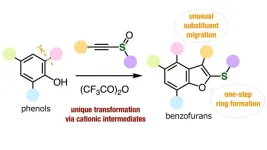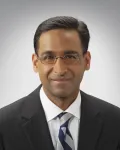(Press-News.org) In their ongoing quest to develop a range of methods for managing plasma so it can be used to generate electricity in a process known as fusion, researchers at the U.S. Department of Energy’s (DOE) Princeton Plasma Physics Laboratory (PPPL) have shown how two old methods can be combined to provide greater flexibility.
While the two methods – known as electron cyclotron current drive (ECCD) and applying resonant magnetic perturbations (RMP) – have long been studied, this is the first time researchers have simulated how they can be used together to give enhanced plasma control.
“This is kind of a new idea,” said Qiming Hu, a staff research physicist at PPPL and lead author of a new paper published in Nuclear Fusion about the work, which has also been demonstrated experimentally. “The full capabilities are still being figured out, but our paper does a great job of advancing our understanding of the potential benefits.”
Ultimately, scientists hope to use fusion to generate electricity. First, they will need to overcome several hurdles, including perfecting methods for minimizing bursts of particles from the plasma that are known as edge-localized modes (ELMs).
“Periodically, these bursts release a little bit of pressure because it’s too much. But these bursts can be dangerous,” said Hu, who works for PPPL at the DIII-D National Fusion Facility, a DOE user facility hosted by General Atomics. DIII-D is a tokamak, a device that uses magnetic fields to confine a fusion plasma in a donut shape. ELMs can end a fusion reaction and even damage the tokamak, so researchers have developed many ways to try to avoid them.
“The best way we’ve found to avoid them is by applying resonant magnetic perturbations, or RMPs, that generate additional magnetic fields,” said PPPL Principal Research Physicist Alessandro Bortolon, who was one of the co-authors of the paper.
Magnetic fields generate islands, microwaves adjust them
The magnetic fields initially applied by the tokamak wind around the torus-shaped plasma, both the long way – around the outer edge, and the short way – from the outer edge and through the center hole. The additional magnetic fields created by the RMPs travel through the plasma, weaving in and out like a sewer’s stitch. These fields produce oval or circular magnetic fields in the plasma called magnetic islands.
“Normally, islands in plasmas are really, really bad. If the islands are too big, then the plasma itself can disrupt.”
However, the researchers already knew experimentally that under certain conditions, the islands can be beneficial. The hard part is generating RMPs big enough to generate the islands. That’s where the ECCD, which is basically a microwave beam injection, comes in. The researchers found that adding ECCD to the plasma’s edge lowers the amount of current required to generate the RMPs necessary to make the islands.
The microwave beam injection also allowed the researchers to perfect the size of the islands for maximum plasma edge stability. Metaphorically, the RMPs act like a simple light switch that turns the islands on, while the ECCD acts like an additional dimmer switch that lets the researchers adjust the islands to the ideal size for a manageable plasma.
“Our simulation refines our understanding of the interactions in play,” Hu said. “When the ECCD was added in the same direction as the current in the plasma, the width of the island decreased, and the pedestal pressure increased. Applying the ECCD in the opposite direction produced opposite results, with island width increasing and pedestal pressure dropping or facilitating island opening.”
ECCD at the edge, instead of the core
The research is also notable because ECCD was added to the plasma’s edge instead of the core, where it is typically used.
“Usually, people think applying localized ECCD at the plasma edge is risky because the microwaves may damage in-vessel components,” said Hu. “We’ve shown that it’s doable, and we’ve demonstrated the flexibility of the approach. This might open new avenues for designing future devices.”
By lowering the amount of current required to generate the RMPs, this simulation work could ultimately lead to lowering the cost of fusion energy production in commercial-scale fusion devices of the future.
This work was funded by the DOE under award numbers DE-AC02-09CH11466, DE-FC02-04ER54698, DE-SC0022270 and DE-AC52-07NA27344. Co-author Qingquan Yu was partially supported by the EUROfusion Enabling Research project (CfP-FSD-AWP24-ENR). His work has been carried out within the framework of the EUROfusion Consortium, funded by the European Union via the Euratom Research and Training Programme grant number 101052200.
PPPL is mastering the art of using plasma — the fourth state of matter — to solve some of the world's toughest science and technology challenges. Nestled on Princeton University’s Forrestal Campus in Plainsboro, New Jersey, our research ignites innovation in a range of applications including fusion energy, nanoscale fabrication, quantum materials and devices, and sustainability science. The University manages the Laboratory for the U.S. Department of Energy’s Office of Science, which is the nation’s single largest supporter of basic research in the physical sciences. Feel the heat at https://energy.gov/science and https://www.pppl.gov.
END
Creating an island paradise in a fusion reactor
Researchers successfully simulate a novel combination method for managing fusion plasma
2024-04-16
ELSE PRESS RELEASES FROM THIS DATE:
Field-margin wetlands alone can’t fix the Gulf of Mexico’s dead zone
2024-04-16
Each summer, a hypoxic dead zone forms in the Gulf of Mexico, making some marine habitats unlivable. The dead zone is caused by nutrients—primarily from agricultural fertilizers—flowing into the Gulf from the Mississippi River. Restoring wetlands at field margins has been proposed to intercept some of the runoff, as wetland plants and soils are capable of absorbing nutrients like a living sponge. But estimates of nutrient removal by restored wetlands have varied widely. Shan Zuidema and colleagues took a whole-system approach to modeling the potential for wetlands to ameliorate the flow of nitrate to the ...
Research has lost none of its innovative drive
2024-04-16
A high-profile study made headlines in 2023 stating that the scientific and innovation system is producing less and less completely new knowledge. Researchers at the University of Basel are now refuting this claim, at least for patents: It is based on a measurement error.
The discovery of mRNA in the 1960s was groundbreaking. Suddenly there were completely new findings that ushered in new developments. This kind of discovery is described as “disruptive”. In contrast, research findings are “consolidating” when they build upon existing knowledge. They are also important, as the example of the ...
A nematode gel to protect crops in Africa and Asia
2024-04-16
The fall armyworm is a destructive corn pest, which recently arrived in Africa and Asia from the Americas and began causing major yield losses and increased use of insecticides, which pose environmental and human health risks. Entomopathogenic nematodes are soil-dwelling roundworms that can parasitize and kill fall armyworms with no risks to people or the environment, but application can be tricky because the nematodes are susceptible to desiccation and UV radiation from sunlight. Patrick Fallet and colleagues report success using an innocuous biodegradable ...
Breakthrough in benzofuran synthesis: New method enables complex molecule creation
2024-04-16
In the field of organic chemistry, scientists are always looking out for new types of reactions to unlock synthesis routes for challenging compounds. Most of the progress that we have witnessed in pharmaceutics and agrochemicals over the past few decades can be traced back to the discovery of novel practical reaction pathways. Such pathways often involve the selective replacement of a functional group with another, the formation of aromatic rings, or the strategic cleaving of parts of a molecule. But what about the rearrangement of existing functional groups within a molecule?
Also known as ‘substituent ...
Exploring the interactions between baby marmosets and their caregivers
2024-04-16
The connection that infants form with their parents or caregivers is crucial for their cognitive, social, and emotional development. These attachments vary in quality, depending on how caregivers respond to the infant's needs. When caregivers are attentive, infants are likely to develop secure attachments. However, if caregivers neglect their needs, infants may develop insecurity, leading to challenges in emotional development and difficulty in forming healthy relationships later in life.
To understand how parenting influences attachment formation and child development, researchers led by Associate Professor Atsuko ...
MD Anderson and CureVac enter strategic collaboration to develop novel cancer vaccines
2024-04-16
HOUSTON and TÜBINGEN, Germany ― The University of Texas MD Anderson Cancer Center and CureVac N.V. today announced a co-development and licensing agreement to develop novel mRNA-based cancer vaccines.
The collaboration creates strong synergies between CureVac’s unique end-to-end capabilities for cancer antigen discovery, mRNA design, and manufacturing and MD Anderson’s expertise in cancer antigen discovery and validation, translational drug development, and clinical research. The collaboration will focus on the development of differentiated cancer vaccine ...
Deadly bacteria show thirst for human blood
2024-04-16
PULLMAN, Wash. – Some of the world's deadliest bacteria seek out and feed on human blood, a newly-discovered phenomenon researchers are calling “bacterial vampirism.”
A team led by Washington State University researchers have found the bacteria are attracted to the liquid part of blood, or serum, which contains nutrients the bacteria can use as food. One of the chemicals the bacteria seemed particularly drawn to was serine, an amino acid found in human blood that is also a common ingredient in protein drinks.
The research finding, published in the journal eLife, provides new insights into how bloodstream infections ...
New insights could unlock immunotherapy for rare, deadly eye cancer
2024-04-16
New research from the University of Pittsburgh explains why metastatic uveal melanoma is resistant to conventional immunotherapies and how adoptive therapy, which involves growing a patient’s T cells outside the body before reinfusing them, can successfully treat this rare and aggressive cancer.
In a paper published today in Nature Communications, the Pitt researchers also explain how they developed a new clinical tool that predicts which patients will respond to adoptive therapy. The work, supported by UPMC Enterprises, is helping improve personalized therapies and avoid futile treatments for metastatic uveal melanoma.
“The dogma was that uveal melanoma is ...
Biodiversity is key to the mental health benefits of nature, new study finds
2024-04-16
New research from King’s College London has found that spaces with a diverse range of natural features are associated with stronger improvements in our mental wellbeing compared to spaces with less natural diversity.
Published in Scientific Reports and funded by the National Institute for Health and Care Research (NIHR) and Wellcome, this citizen science study used the smartphone application Urban Mind to collect real-time reports on mental wellbeing and natural diversity from nearly 2000 participants.
Researchers found that environments with ...
A single atom layer of gold – LiU researchers create goldene
2024-04-16
For the first time, scientists have managed to create sheets of gold only a single atom layer thick. The material has been termed goldene. According to researchers from Linköping University, Sweden, this has given the gold new properties that can make it suitable for use in applications such as carbon dioxide conversion, hydrogen production, and production of value-added chemicals. Their findings are published in the journal Nature Synthesis.
Scientists have long tried to make single-atom-thick sheets of gold but failed because the metal’s tendency to lump together. But ...
LAST 30 PRESS RELEASES:
First Editorial of 2026: Resisting AI slop
Joint ground- and space-based observations reveal Saturn-mass rogue planet
Inheritable genetic variant offers protection against blood cancer risk and progression
Pigs settled Pacific islands alongside early human voyagers
A Coral reef’s daily pulse reshapes microbes in surrounding waters
EAST Tokamak experiments exceed plasma density limit, offering new approach to fusion ignition
Groundbreaking discovery reveals Africa’s oldest cremation pyre and complex ritual practices
First breathing ‘lung-on-chip’ developed using genetically identical cells
How people moved pigs across the Pacific
Interaction of climate change and human activity and its impact on plant diversity in Qinghai-Tibet plateau
From addressing uncertainty to national strategy: an interpretation of Professor Lim Siong Guan’s views
Clinical trials on AI language model use in digestive healthcare
Scientists improve robotic visual–inertial trajectory localization accuracy using cross-modal interaction and selection techniques
Correlation between cancer cachexia and immune-related adverse events in HCC
Human adipose tissue: a new source for functional organoids
Metro lines double as freight highways during off-peak hours, Beijing study shows
Biomedical functions and applications of nanomaterials in tumor diagnosis and treatment: perspectives from ophthalmic oncology
3D imaging unveils how passivation improves perovskite solar cell performance
Enriching framework Al sites in 8-membered rings of Cu-SSZ-39 zeolite to enhance low-temperature ammonia selective catalytic reduction performance
AI-powered RNA drug development: a new frontier in therapeutics
Decoupling the HOR enhancement on PtRu: Dynamically matching interfacial water to reaction coordinates
Sulfur isn’t poisonous when it synergistically acts with phosphine in olefins hydroformylation
URI researchers uncover molecular mechanisms behind speciation in corals
Chitin based carbon aerogel offers a cleaner way to store thermal energy
Tracing hidden sources of nitrate pollution in rapidly changing rural urban landscapes
Viruses on plastic pollution may quietly accelerate the spread of antibiotic resistance
Three UH Rainbow Babies & Children’s faculty elected to prestigious American Pediatric Society
Tunnel resilience models unveiled to aid post-earthquake recovery
Satellite communication systems: the future of 5G/6G connectivity
Space computing power networks: a new frontier for satellite technologies
[Press-News.org] Creating an island paradise in a fusion reactorResearchers successfully simulate a novel combination method for managing fusion plasma








